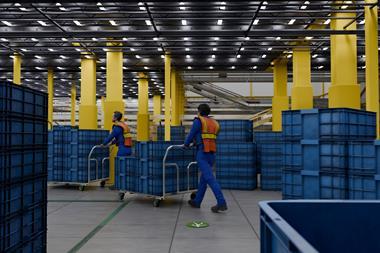Ensuring efficient replenishment can give a retailer sleepless nights. With the trend for sacrificing warehouse for retail space and the move to just-in-time replenishment, getting stock into the store and straight out onto the shelves can be a difficult task.
Road congestion makes replenishing overnight the ideal solution, but security issues, staffing problems and delivery curfews can mean that is easier said than done. Yet night-time deliveries can prove a huge bonus for retailers. The automotive industry is particularly slick when it comes to replenishing overnight and many believe it could teach the retail sector a lesson. “Dealers drive a stockless environment, so they need overnight replenishment to deliver on consumer expectations,” says Christian Salvesen sales and marketing director, transport UK, Stuart Lloyd.
The supermarket sector, because of the sheer volume of stock needed to replenish its stores, is another big user of out-of-hours deliveries. “They’re essential. They enable our customers to buy fresh food from the moment we open our doors in the morning,” says a Sainsbury’s spokeswoman. “It also enables us to avoid peak times on the road, thus reducing our contribution to already-congested rush-hour routes, increasing our fuel efficiency and reducing our contribution to CO_ emissions,” she says.
Sainsbury’s works hard to minimise night-time disturbance, with quieter roll cages, refrigerated vehicles and tail lifts on delivery vans. Strict guidelines are also issued to stores and depots to reduce behavioural noise, such as shouting. “In addition, we continually evaluate our fleet to utilise new technology and reduce our impact, so that deliveries not only become less noisy, but are more efficient,” says the spokeswoman. With that in mind, vehicles are leased for just four years before being updated.
Although Sainsbury’s works with councils to create store-specific action plans to reduce late-night noise disturbance to residents, some boroughs persist in imposing curfews on retailers delivering after hours. The supermarket chain works to ensure a balanced approach is taken and has recently signed up to the Freight Quality Partnership for South London – a Government-funded group of local authorities and businesses working on the issue of freight movement.
The lack of uniformity of delivery curfews can make them a real challenge to observe. In a survey by Transport for London, one retailer had delivery curfews on half of their London stores – but with 15 different start times and 30 different end times. A poll by the BRC in 2005 found that 32 per cent of the 7,000 stores surveyed had been disadvantaged by laws surrounding delivery times – and that a relaxation of curfews could save retailers£30 million a year.
Lloyd says Christian Salvesen will use its systems to identify which stores can and can’t accept night-time deliveries. “It’s all about planning. We have established a national database of restrictions and can easily identify where there is a vehicle ban,” he says.
Asda also delivers during the night and experiences similar problems to its rival. “The delivery window for getting in all our fresh produce is tight, but the depots and stores are used to this and it’s normal practice for them,” says a spokesman.
Other sectors of retail are also picking up on the overnight delivery trend. Peacocks has used ANC Logistics’ Nightvision service to deliver goods to its stores within the M25 area for the past four years. Staff in a double-manned vehicle – needed because of the security precautions of delivering after-hours – have access to the back of store to drop off deliveries.
Peacocks logistics director Laurie Hynds believes there are a number of benefits, including a reduction of lead times into stores. “And the staff don’t have the distraction of dealing with deliveries, so they can do what they should be doing: selling,” he says.
Hynds admits that retailers can be wary about the safety of stock and stores when allowing night-time access, but ANC Logistics business development director Martin Covey says there are strict checks in place. “Our staff are all tracked and we have additional security people who follow our deliveries on an ad-hoc basis,” he explains. He admits the service can prove a little more costly, but says payback comes from other benefits, such as added sales because of immediate stock availability.
There is a human element to night-time deliveries and replenishment, too: the challenge of managing overnight teams, especially in supermarkets open for 24-hour trading. Paul Gilligan, store manager of Sainsbury’s Islington, knows all too well the pressure of after-hours deliveries. He has five deliveries and a team of 10 people working on replenishing fresh foods overnight. However, his full out-of-hours team can comprise 35 people. Managing such a workforce is a demanding role for a night manager, he admits. “It’s pressurised – you need to ensure high output – and requires real engagement. And the hours are unsociable, too. It takes an inspirational leader,” he says.
Envision Retail director Jason Kemp agrees. “If you replenish in the morning, then you have very little time, so you need a large team. If you do it overnight, you require a smaller number of people over a longer period but you have to pay a premium salary. It can be difficult recruiting and holding on to quality staff and good managers who are prepared to work at night,” he says.
Retailers that rely on overnight deliveries and replenishment can also inadvertently put themselves at risk if they do not have a reliable team in place. Kemp is a former retailer and recounts a time when he arrived at work at a department store food hall an hour before the store was due to open to find lorries waiting outside because no one from the night shift had turned up over a bank-holiday weekend. “They had all gone to the Notting Hill Carnival,” says Kemp. “It was the worst day of my life. But that’s the risk you take when there’s that much at stake in one operation,” he says.
There can also be communication difficulties with such teams. “I worked in one store with 16 staff who spoke 14 languages between them, so it was very difficult to manage,” says Kemp.
The move to trading 24 hours stemmed from night-time replenishment. If the retailer was already paying lighting, staffing and heating costs, then the marginal cost of opening to trade seemed to make sense. But the replenishment process needs to be carefully balanced with consideration for customers and replenishment staff need to have customer-facing skills. “And that makes recruitment even more challenging,” says Kemp. Asda says this isn’t a problem for its staff, who replenish 70 per cent of the store overnight and 30 per cent during the day. “The company’s training programme ensures that our colleagues are trained in replenishment as well as customer-facing skills, so that they can support any queries thought the night,” says the spokesman.
Somerfield does the same. “All non-management and supervisory staff learn customer-facing skills as part of their induction and colleagues whose primary role, for example, is shelf filling, will have checkout as their secondary role,” says Somerfield central operations simplification manager Adrian Peace.
However, because of the challenges, some stores are abandoning around-the-clock trading. “I stopped it,” admits Gilligan. “We needed a cut-off period in which to be able to concentrate on replenishment,” he says. Indeed, only five Sainsbury’s stores nationwide are now open 24 hours.
Of course, the case for night deliveries and replenishment depends on the requirements of the individual store. “There are lots of operational advantages to being well stocked on opening,” says Kemp. “I can see it becoming more popular with smaller operators because they don’t have such extreme needs at the start of the day,” he says. And it seems more retailers than ever are waking up to the advantages.


























No comments yet